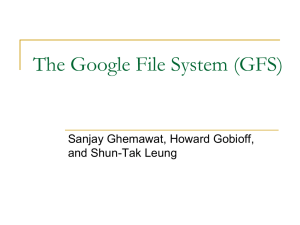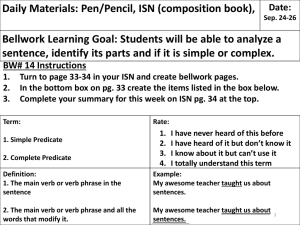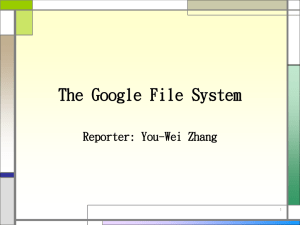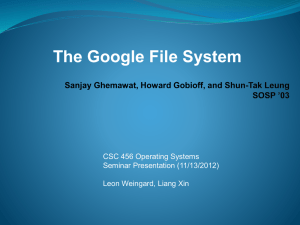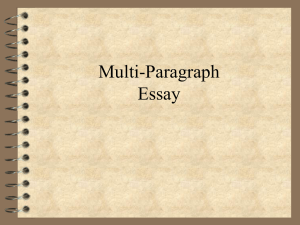Heap Management
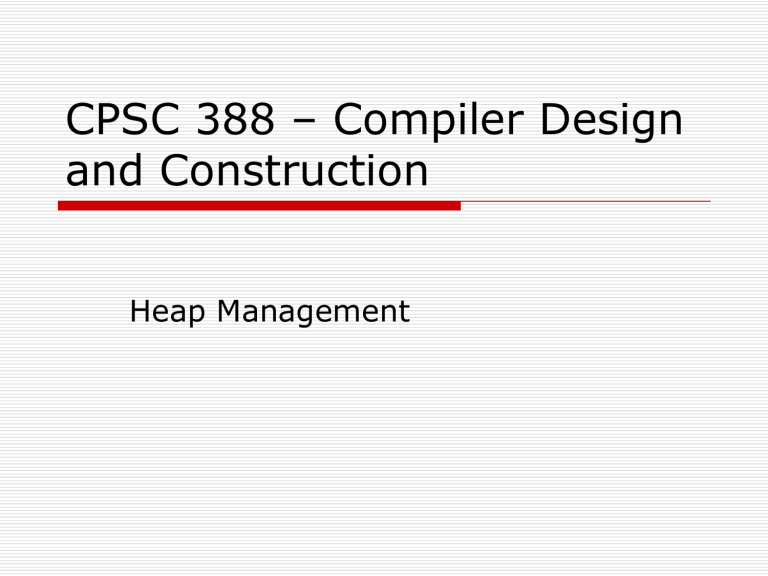
CPSC 388 – Compiler Design and Construction
Heap Management
Areas of Memory Used by Program
Program Code
Static Data
Heap
Stack
Heap
Used for dynamically allocated memory
Important operations include allocation and deallocation
In C++, Pascal, and Java allocation is done via the
“new” operator
In C allocation is done via the “malloc” function call
De-allocation is done either automatically or programmer must specify when to de-allocate memory:
Pascal and C++ – dispose
C – free
Java – garbage collection
Managing the Heap
Available memory is managed using a free list: a list of available “chunks”
Each chunk includes:
Size of chunk
Address of the next item on the free list
The chunk itself
Initial Heap Free List
0 4 …
100 \ …
103
First
Free size next
Request is made to allocate 20 bytes
Uses first portion of first chunk (after size
Field) and returns address of 4
Initial Heap Free List
0 4 … 23 24 28 …
20 76 \ size size next
First
Free
Request is made to allocate 10 bytes
103
Initial Heap Free List
0 4 … 23 24 28 …37 38 42 …
20 10 62 \ size size size next
First
Free
First chunk is freed
Adds chunk to front of free list
103
Initial Heap Free List
First
Free
0 4 … 23 24 28 …37 38 42 …
20 10 62 \ size size size next
103
Operations on Free List
Request space
Find a satisfactory chunk
Free Space
Return to Free List
Goals for Operations
Only fail to satisfy request for n bytes if there are not n bytes available on free list
Do both operations quickly
Questions to Consider
Given a request for n bytes, which n bytes to return?
Given a de-allocation of a chunk, how to coalesce it with neighboring free chunks?
Techniques for Allocation
Best Fit: Find the chunk on the freelist with the smallest size greater than or equal to allocation request
May require search of entire freelist
(SLOW!)
Leaves lots of little pieces of free storage on the list
Techniques for Allocation
First Fit: Use the first chunk with size greater than or equal to n.
Faster than best-fit.
Produces little pieces of free storage at the front of the list, which slows later searches
Techniques for Allocation
Circular First Fit: Make the freelist circular (i.e. have last item point back to the first item).
Satisfy requests using the first chunk with size greater than or equal to n.
Change the freelist pointer to point to next chunk after allocated one.
Techniques for de-allocation
Use a doubly-linked list
Each Chunk has a previous and next pointer
One bit of size field reserved to indicated if chunk is “free” or “in-use”.
Check free bit of storage after chunk
If following chunk is free then coalesce
Follow Example on Board
Techniques for De-allocation
Can also coalesce with preceding chunk if you keep the size of chunk at beginning and end of chunk
Follow example on board
Note that NO pointers need to be updated
Automatic or Explicit De-allocation
In C++ and C de-allocation must be done explicitly
In Java de-allocation is done automatically (by the garbage collector)
Making it Automatic reduces burden on the programmer (and eliminates some types of errors)
Errors of Explicit De-allocation
Storage Leaks
Some storage is never freed even though it is inaccessible
Listnode *p = malloc( sizeof(Listnode) );
.
. // no copy from p in this code
.
p = ...;
Errors of Explicit De-allocation
Dangling pointers
A pointer that points to memory that has been freed
May read garbage
May mess up free list
May corrupt other variables
Example Dangling Pointers
Listnode *p, *q; p = malloc( sizeof(Listnode) ); q = p;
.
. // no assignment to q in this code
.
free(p);
.
. // no assignment to q in this code
.
*q = ...
Detecting Dangling Pointers
Add a new field to every allocated chunk (like size field) (lock)
Add a new field to every pointer (in addition to storing the address) (key)
If lock does not match key then throw an error
Detecting Dangling Pointers
Each free chunk’s lock is set to 0
When allocated both lock and key assigned a new value (always increasing)
When storage is freed set lock back to zero
When pointer is dereferenced, compiler generates code to first match key to lock, otherwise cause error
Automatic De-allocation
Determine if a chunk of storage is no longer accessible to the program
Make de-allocation efficient, avoid long pauses in program’s execution during de-allocation
Two Approaches:
Reference Counting
Garbage Collection
Reference Counting
Include invisible field in every chunk of storage: its reference count field.
Value of field is the number of pointers that point to the chunk.
Value is initialized to 1 when chunk is allocated and updated:
When a pointer is copied, a new reference is created, so the reference count of chunk must be incremented
When a non-null pointer’s value is over-written, a reference is removed, so the reference count of the chunk (before the over-write) must be decremented.
When a reference count becomes zero, it means nothing points to it so the chunk can be de-allocated and added to free list. If the chunk contains pointers to other chunks, then their reference counts must be decrimented.
Problems with Reference Counting
Slows Program Execution
Every write into a pointer must test to see if old value is null.
Requires updates to reference counts
Cyclic Structures cannot be deallocated var p: Nodeptr; /* p is a pointer to a node */ new(p); /* p points to new storage, reference count is 1 */ p^.next = p; /* next field of node points to node, so now reference count is 2 */ p = nil; /* p's value is over-written, so node's reference count decremented(from 2 to 1)
In fact, it is inaccessible (it points to itself, no other pointer points to it), but we can't tell that just from the reference count. */
Garbage Collection
Wait until no stoarge left then
Find all accessible objects
Free all other (inaccessible) objects
Several Approaches to Garbage
Collection
Mark and Sweep
Stop and Copy
Mark and Sweep
Two Phases
Mark phase finds and marks all accessible objects
Sweep phase sweeps through the heap, collecting all of the garbage and putting back on freelist
Another “invisible” value in each chunk called mark bit
Initialized to 0
Set to 1 if the chunk is reached during mark phase
Mark Phase
Put all “active” pointers on a worklist
(“active” means pointer is on stack or static data area)
While worklist is not empty do: p=select_pointer(worklist) if p’s object’s mark-bit is zero: change it to one put all pointers in p’s object on worklist
Sweep Phase
Looks at every chunk of storage in heap
How?
If mark-bit for chunk is 0 add to freelist
If mark-bit for chunk is 1 change to 0
When adding to freelist coalesce neighbor chunks
See example on board
Stop and Copy Garbage Collection
Heap is divided into two parts:
Old space used for allocation of new chunks
New space used for garbage collection
First-free pointer points to first free space in old space
When allocation request is made for n bytes, if space is available in old space then make allocation, otherwise perform garbage collection
Stop and Copy Garbage Collection
Find all accessible objects (following same method as mark and sweep)
Copy the object from old space to new space (no mark bit)
After making all copies, reverse role of old and new space
First-free pointer points to beginning of the “new” old space
Stop and Copy Garbage Collection
When chunk is copied from old to new, ALL pointers to chunk must be updated
A forwarding pointer is left behind in old space and used to update other pointers to same object
Follow example on board
Advantages of Stop and Copy
Allocation is Cheaper (no need for searching free list, just advance first-free pointer)
No Freelist, just one chunk of free memory, no need to coalesce chunks
Cheaper than mark and sweep – no need to scan entire heap
Compacting objects means closer together
(fewer cache misses, fewer page faults)
Identifying Pointers
Automatic deallocation requires the ability to find all pointers on the stack
Every word has a one-bit tag (0 for notpointer, 1 for pointer)
Maintain separate bit-map of tags
Associate with each variable and each object a type tag.
Summary
Two methods of Storage De-allocation
Programmer controlled
Automatic
Programmer controlled errors include:
Storage leaks
Corrupted memory via dangling pointers
Automatic De-allocation
Reference counting
High space and time overhead
Cannot free cyclic structures
Cost is distributed over the execution of program
Garbage collection
Mark and Sweep
Stop and Copy
